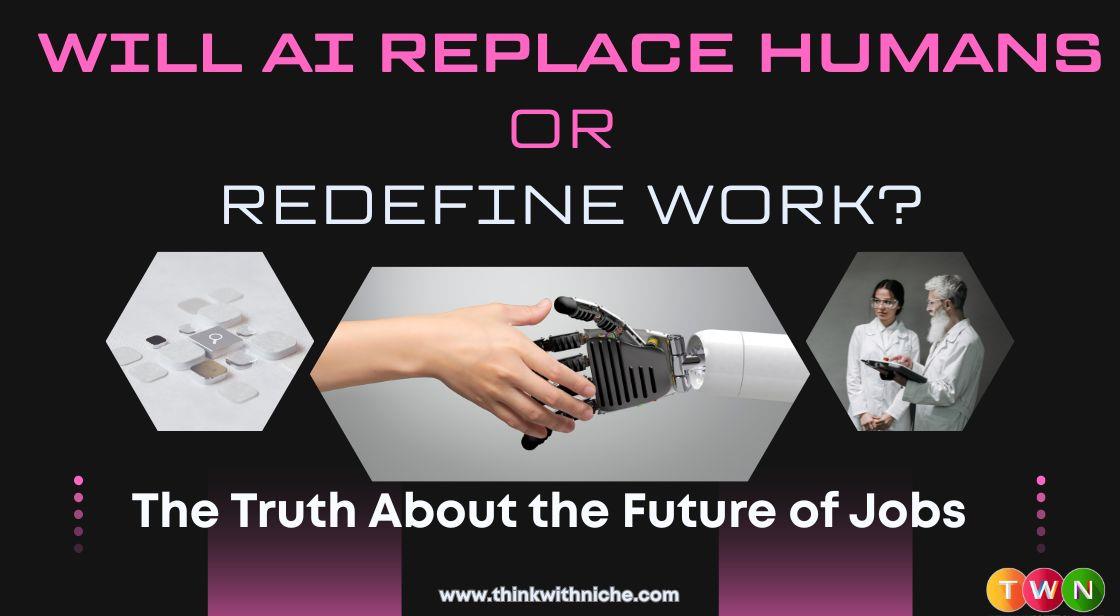Will AI Replace Humans or Redefine Work? The Truth About the Future of Jobs

Blog Post
The rapid and unprecedented advancement of Generative Artificial Intelligence (GenAI) has forcefully revived a centuries-old economic debate: will automation ultimately destroy more jobs than it creates, or is it the trigger for a productivity boom vast enough to elevate global wages and living standards?
The consensus among leading economic institutions is that the future of work will be defined less by mass unemployment and more by a profound, rapid, and often painful redefinition of existing roles.
The initial wave of automation targeted manual and highly repetitive tasks. However, GenAI tools, like large language models, are now directly affecting white-collar work, the very segment once considered safe.
This shift demands a strategic, coordinated response from governments, corporations, and individuals.
To understand this transformation, we must examine three crucial data points: where job losses are emerging, which new high-value roles are gaining traction, and the necessary policy and corporate actions to ensure equitable and inclusive growth.
Artificial Intelligence and Employment: Threat or Transformation?
Where Job Displacement is Accelerating: The White-Collar Threat
Unlike previous automation waves that focused on manufacturing floors, GenAI’s immediate impact is concentrated in service, clerical, and legal support roles—the traditional engine of mid-career stability. The core mechanism is GenAI's ability to efficiently handle cognitive, non-routine tasks involving language, data parsing, and content creation.
1. The Call Center and Customer Service Exodus
Generative AI is proving to be a highly effective "AI Copilot," not just by handling basic queries but by augmenting the productivity of human agents significantly. An NBER working paper tracking agents at a U.S. software firm found an AI copilot raised average productivity by 14%. While this is presented as an aid, management is increasingly consolidating teams and relying on the AI to quickly bring novice workers up to the veterans' level.
- 2025 Data Point: Industry reports indicate that AI chatbots are replacing large call center teams and that entry-level service jobs face substantial vulnerability as companies pivot toward "AI-first" customer interactions.
-
The Outcome: The primary impact is the consolidation of roles, leading to fewer entry-level positions and increased pressure on remaining human staff to handle more complex or empathetic interactions.
2. Legal, Clerical, and Content Services Under Siege
Routine administrative and content-based tasks are highly exposed to large-language-model (LLM) automation.
-
Legal Support: Research from institutions like the University of Pennsylvania and OpenAI shows that legal clerks and paralegals rank in the top decile for exposure, with at least half of their core tasks being automatable. Early adopters, such as major law firms, report that GenAI drafts first-pass memos and briefs in minutes, significantly trimming billable hours for routine legal work.
-
Administrative and Clerical Roles: The World Economic Forum’s (WEF) Future of Jobs Report 2025 projects a net loss of clerical and secretarial roles as generative tools take over copy editing, report drafting, and basic design tasks. Media companies confirm that experimenting with AI headlines, video summaries, and basic editorial review means fewer junior editors are needed per project.
Goldman Sachs Research estimates that up to 300 million full-time jobs worldwide could be automated as the technology matures, with two-thirds of current occupations exposed to some degree of task change—a clear signal that the disruption is pervasive across the global economy.
Also Read: Top 15 Most Influential AI Leaders You Must Know
Where New Jobs Are Appearing: The Rise of the AI Complement
The narrative isn't purely one of loss; it is one of technological substitution and creation. Automation does not necessarily eliminate employment; it redefines the skill mix inside most professions. The greatest demand is shifting toward roles that are either required to build, manage, and secure the AI infrastructure, or that leverage human-centric skills (creativity, critical thinking, empathy) to maximize AI’s utility.
1. Exponential Demand for AI Specialists
The WEF Future of Jobs Report 2025 reveals that a net total of 78 million jobs will be created by 2030 globally, largely driven by technological adoption. Specifically, demand for AI and Machine Learning Specialists is projected to surge by 40% through 2027, adding nearly one million positions.
The fastest-growing roles commanding significant wage premiums include:
-
Data Analysts and Data Scientists
-
Cybersecurity Specialists
-
Prompt Engineers: Specialists who design and optimize inputs (prompts) to guide GenAI models to produce the most accurate and useful outputs.
- AI Ethics and Governance Specialists: Roles focused on ensuring responsible, fair, and transparent deployment of AI systems.
2. The Great Reskilling Imperative
This profound shift highlights a skills paradox. While the number of jobs may not collapse, the required skills are changing dramatically. IBM’s Institute for Business Value study reinforces this, noting that an estimated 40% of the global workforce will require some degree of reskilling within three years due to AI adoption.
This means the technology isn't just killing roles; it's forcing a rapid obsolescence of certain skill sets. The economic winners will be those who can quickly pivot to become AI-Augmented Professionals—using AI tools to achieve a level of productivity a human alone cannot.
The Inequality Challenge: Risk of Wage Polarization
The core social problem posed by AI is not the simple unemployment figure, but the potential for a severe widening of the wage polarization gap.
1. The Disparity in Exposure and Resources
While sophisticated white-collar, higher-paid jobs carry the greatest exposure to AI task automation (according to Goldman Sachs), the social danger lies in the inverse relationship between exposure and resources for adaptation.
-
At-Risk Workers: Low-income employees, whose roles may be slightly less exposed but whose wages are already stagnant, have fewer financial resources to invest in retraining for the emerging high-tech roles.
-
The Wealth Gap: Research from the IMF highlights that while AI might reduce wage inequality by displacing high-income workers, it is likely to substantially increase wealth inequality as the same high-income professionals benefit from higher returns on capital (stock and ownership) in the AI-driven companies.
Without swift and visible policy intervention, this gap will intensify, as warned by the McKinsey Global Institute. The political sustainability of AI adoption hinges on creating visible and accessible pathways for at-risk workers to pivot into new, meaningful, and well-compensated roles.
We risk creating a society where a hyper-skilled elite designs and manages the AI, while a larger segment is left with precarious gig-work, constantly retraining for transient roles.
A Strategic Path Forward: Government and Corporate Action
Steering the AI wave toward inclusive growth requires a coordinated, dual-pronged strategy involving both regulatory guardrails and proactive investment in human capital.
1. Government Imperatives: Regulation and Lifelong Learning
Governments must move beyond simple observation to become active architects of the AI transition.
-
Regulation for Trust: Nations like the European Union, with its landmark AI Act, are establishing clear transparency and risk-management duties on companies deploying advanced models. This aims to build public trust and ensure accountability without stifling innovation.
- Funding Reskilling: To spread both the risks and rewards of automation, governments must combine regulatory guardrails with broad-based training subsidies. This includes integrating AI literacy into public education and launching national upskilling missions, such as the roadmap outlined in the NITI Aayog’s AI for Viksit Bharat initiative in India, which aims to position the country as a global hub for AI talent by 2035.
2. Corporate Responsibility: Upskill Over Layoff
For corporations, workforce transition is not a compliance chore but a strategic economic asset. Upskilling current staff often proves to be far more cost-effective and beneficial than relying solely on external hiring.
-
Preserving Institutional Knowledge: As IBM’s CHRO noted to Harvard Business Review, retraining is more cost-effective for advanced analytics roles. Internal mobility preserves institutional knowledge and reduces the onboarding risk and cost associated with external hiring.
-
Large-Scale Initiatives: Multinationals are leading the way:
-
Microsoft’s Global Skills Initiative has trained millions in digital competencies, with new modules released for GenAI proficiency.
-
Amazon offers employees free enrollment in its Machine Learning University, with internal data showing reskilled workers move into higher-paid technical roles within two years.
-
A 2024 PwC survey of investors and analysts confirms this: growth requires significant investment in both AI and human capital capable of steering and validating model outputs. Layoffs without retraining may offer a short-term boost to earnings but ultimately erode the long-term competitiveness required to capitalize on AI's productivity gains.
Conclusion: The Balanced Path Forward
The future of jobs will be shaped by a negotiation between human ingenuity and artificial intelligence. AI is not a singularity that will end human work; it is an economic force that demands a new social contract.
We conclude that the elimination of certain roles in call centers, legal support, and content services is inevitable. Equally certain is the creation of high-value jobs in data science, cybersecurity, and human-centric design. Success lies in balancing these forces: Governments must set clear usage rules and fund lifelong learning, while companies must treat worker redeployment as a strategic asset.
By acting in tandem, policymakers and business leaders can effectively steer the current wave of automation toward a new industrial revolution—one that delivers a productivity boom and inclusive prosperity, rather than mass dislocation and social instability.
You May Like
EDITOR’S CHOICE












